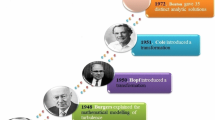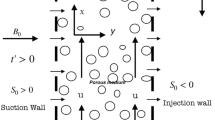Abstract
Both RaNS (Reynolds-averaged Navier–Stokes) and DES (Detached Eddy Simulation) type turbulence models were used in conjunction with a two-fluid model of bubbly flow and a new subgrid air entrainment model to predict air entrainment and transport in a hydraulic jump. It was found that the void fraction profiles predicted by both methods are in agreement with the experimental data in the lower shear layer region, which contains the air bubbles entrained at the so-called toe of the hydraulic jump. In contrast, in the upper roller region behind the toe, the averaged results of the DES turbulence model gives accurate predictions while a RaNS turbulence model does not. This is because the DES turbulence model successfully captures the strong fluctuations on the free surface which allows it to entrain air near the top of the roller region. In contrast, RaNS type turbulence model results in a steady, smooth interface which fails to capture the wave-induced bubble sources in that region. To our knowledge, this study is the first successful quantitative numerical simulation of the overall void fraction profiles in a hydraulic jump.





Similar content being viewed by others
References
Kalinske A, Robertson J (1943) Closed conduit flow. Trans ASCE 108:1435–1447
Rajaratnam N (1962) An experimental study of air entrainment characteristics of the hydraulic jump. J Inst Eng India 42(7):247–273
Resch F, Leutheusser H (1972) Le ressaut hydraulique: mesure de turbulence dans la rgion diphasique. Jl La Houille Blanche 4:279–293
Chanson H (1996) Air bubble entrainment in free-surface turbulent shear flows. Academic Press, Massachusetts
Mossa M, Tolve U (1998) Flow visualization in bubbly two-phase hydraulic jump. J Fluids Eng 120(1):160–165
Chanson H, Brattberg T (2000) Experimental study of the air-water shear flow in a hydraulic jump. Int J Multiph Flow 26(4):583–607
Murzyn F, Mouaze D, Chaplin J (2005) Optical fibre probe measurements of bubbly flow in hydraulic jumps. Int J Multiph Flow 31(1):141–154
Liu Q, Uwe D (1994) Turbulence characteristics in free and forced hydraulic jumps. J Hydraulic Res 32:877–898
Stelling GS, Busnelli MM (2001) Numerical simulation of the vertical structure of discontinuous flows. Int J Numer Methods Fluids 37(1):23–43
Zhou J, Stansby P (1999) 2d shallow water flow model for the hydraulic jump. Int J Numer Methods Fluids 29(4):375–387
Ma J, Oberai A, Drew D, Lahey Jr. R, Hyman M (2009) A comprehensive subgrid air entrainment model for Reynolds-averaged simulations of free-surface bubbly flows. In: APS DFD meeting abstracts
Ma J, Oberai A, Drew D, Lahey R Jr, Hyman M (2011) A comprehensive sub-grid air entrainment model for RaNS modeling of bubbly flows near the free surface. J Comput Multiph Flows 3(1):41–56
Souders DT, Hirt CW (2004) Modeling entrainment of air at turbulent free surfaces. In: Proceedings of world water and environmental resources congress 2004
Gonzlez AE, Bombardelli FA (2005) Two-phase-flow theoretical and numerical models for hydraulic jumps, including air entrainment. In: Proceedings of XXXI IAHR congress
Moraga FJ, Carrica PM, Drew DA, Lahey RT Jr (2008) A sub-grid air entrainment model for breaking bow waves and naval surface ships. Comput Fluids 37(3):281–298
Martinez-Bazan C, Montañes J, Lasheras JC (1999) On the breakup of an air bubble injected into a fully developed turbulent flow. Part 1. Breakup frequency. J Fluid Mech 401:157–182
Larreteguy AE, Drew DA, Lahey Jr. RT (2002) A center-averaged two-fluid model for wall-bounded bubbly flows. In: Proceedings of 2002 joint US ASME/European fluids engineering division summer meeting, Montreal
Moraga FJ, Larreteguy AE, Drew DA, Lahey RT Jr (2006) A center-averaged two-fluid model for wall-bounded bubbly flows. Comput Fluids 35:429–461
Sussman M, Smereka P, Osher S (1994) A level set approach for computing solutions to incompressible two-phase flow. J Comput Phys 114(1):146–159
Carrica P, Wilson R, Stern F (2006) An unsteady single-phase level set method for viscous free surface flows. Int J Numer Methods Fluids 53(2):229–256
Menter FR (1994) Two-equation eddy viscosity turbulence models for engineering applications. AIAA J 32(8):1598–1605
Paterson EG, Wilson RV, Stern F (2003) General-purpose parallel unsteady rans ship hydrodynamics code: Cfdship-Iowa. IIHR Report 432, Iowa Institute for Hydraulic Research. The University of Iowa, Iowa
Travin A, Shur M, Strelets M, Spalart PR (2002) Physical and numerical upgrades in the detached-eddy simulation of complex turbulent flows. Springer, Netherlands, pp 239–254
Moraga FJ, Larreteguy AE, Carrica PM, Drew DA, Lahey Jr. RT (2001) CFDShipM: multiphase code for ship hydrodynamics. Version 3.02.02 users manual
Misra SK, Brocchini M, Kirby JT (2006) Turbulent interfacial boundary conditions for spilling breakers. In: Proceedings of the 30th international conference of coastal engineering
Rodriguez-Rodriguez J, Marugan-Cruz C, Aliseda A, Lasheras JC (2011) Dynamics of large turbulent structures in a steady breaker. Exp Thermal Fluid Sci 35:301–310
Acknowledgments
This work was supported by the Office of Naval Research (ONR), Grant N00014-03-1-0826, under the administration of Dr. Patrick Purtell, and was also supported in part by a generous grants of computer time from the DOD High Performance Computing Modernization Program at the Maui High Performance Computing Center (MHPCC), US Army Engineering and Research Development Center (ERDC) and Arctic Region Supercomputing Center (ARSC). We also thank Dr. Frederic Murzyn at Parc Universitaire de Laval-Change for providing us with his detailed experimental data on void fractions in hydraulic jumps.
Author information
Authors and Affiliations
Corresponding author
Additional information
Dedicated to Prof. Dr.-Ing. Dr.-Ing. E.h. mult. Franz Mayinger on the occasion of his 80th birthday.
Rights and permissions
About this article
Cite this article
Ma, J., Oberai, A.A., Lahey, R.T. et al. Modeling air entrainment and transport in a hydraulic jump using two-fluid RANS and DES turbulence models. Heat Mass Transfer 47, 911–919 (2011). https://doi.org/10.1007/s00231-011-0867-8
Received:
Accepted:
Published:
Issue Date:
DOI: https://doi.org/10.1007/s00231-011-0867-8




